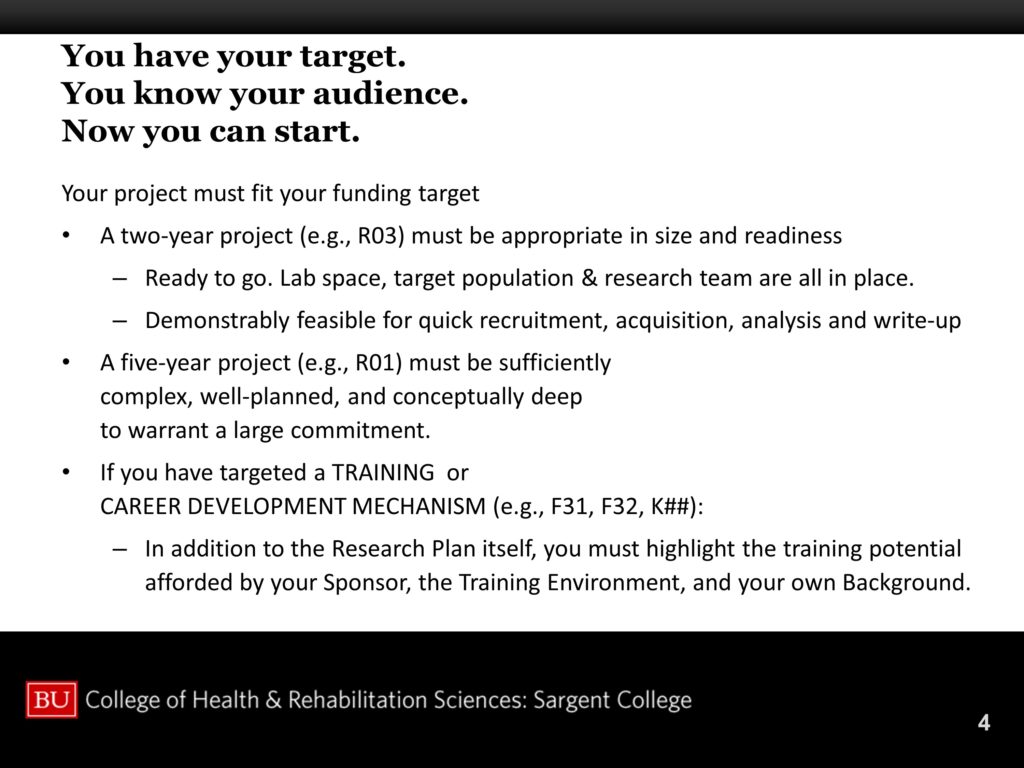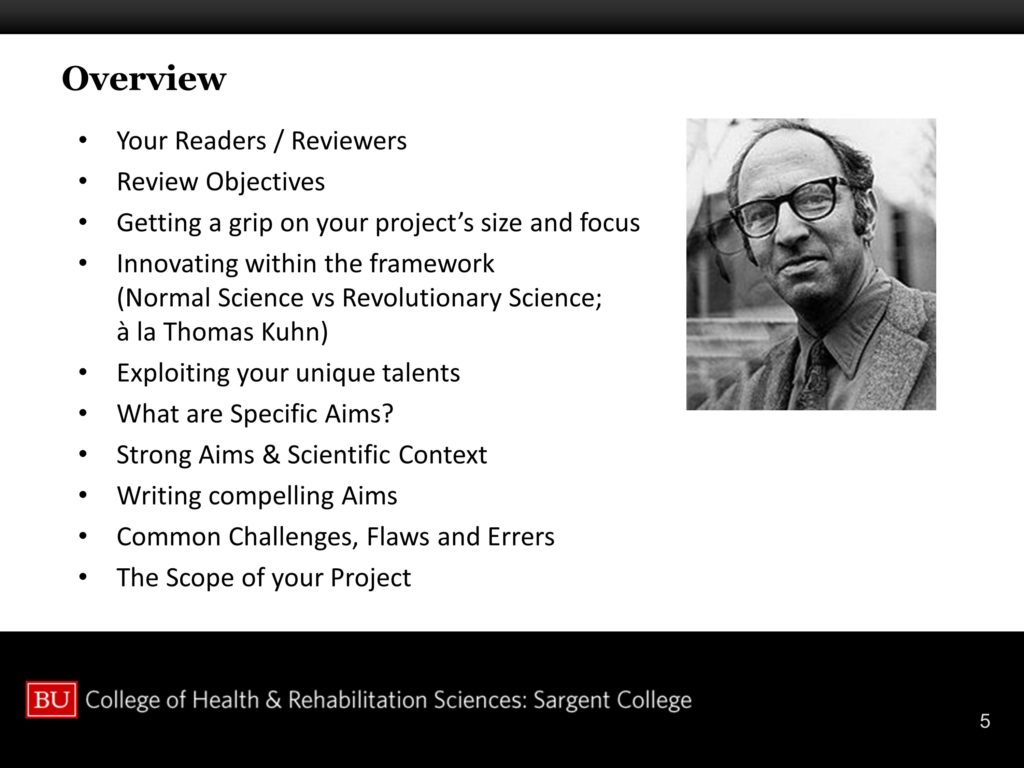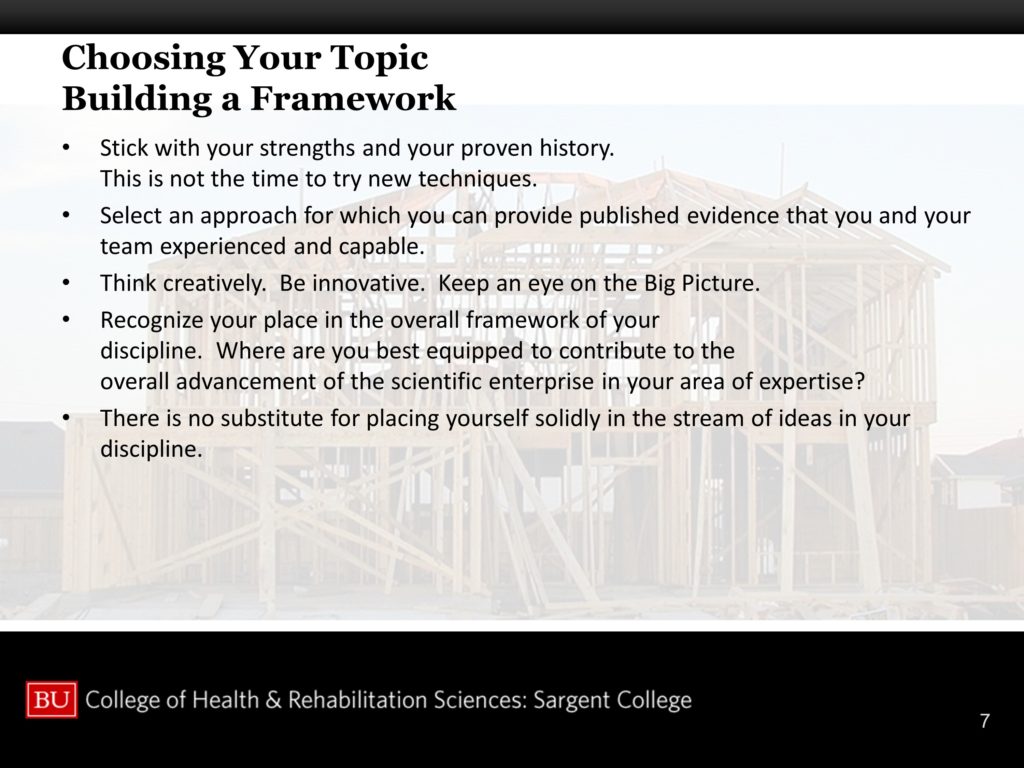The following is a transcript of the presentation video, edited for clarity.
Your Project Must Fit Your Funding Target

The first thing to wrap your mind around is that the project has to be appropriate in size and scope. You’re a new researcher. You have a limited background because you’re new. You probably have limited resources because you’re new to your university and they didn’t give you all the startup you asked for. So it has to be appropriate in size.
It has to be ready to go. Lab space, target population, research team — everything has to be in place. The grant is not to get things in place. The grant is to pay for things that are ready to launch.
It has to be demonstrably feasible. This is hugely important.
Demonstrably feasible. For an R03 things have to happen very fast. For a two- or three-year award, you can’t waste the first six months getting geared up. That’s not what they want to see. It has to be demonstrably feasible for quick recruitment, data acquisition, analysis, and write-up. You want a product in three years.
A five-year project, on the other hand, for an R01, if that’s what you’re working on. That’s a much larger budget. Not only is it a much longer time, but it’s a much larger budget. It’s going to have a much larger team, and it should be sufficiently complex, well planned, and conceptually deep to warrant this kind of large commitment. You really have to show you know what you’re doing organizationally as well as scientifically.
For training or career development mechanisms – if you’re going to be working on an F32 or a K award — K99/R00, K08, K03, K21, K23, all of those are possibilities — then the research plan has to have real training potential. It has to take you to a new place. That has to be a place that your sponsor can take you better than anybody else. This is the best person on the planet to train you in these new techniques, in a well-funded environment that’s already doing all of that stuff, and it builds perfectly on your own background.
Depending on what the mechanism is, the aims for your grant project are doing different things. That’s all this slide is supposed to tell you. You have to make sure you know what you’re writing for. What’s your objective?
Innovating Within the Framework

I want you to look at this part: Innovating within the framework. This is history and philosophy of science. They don’t teach Thomas Kuhn anymore. Thomas Kuhn had this idea that’s really relevant to a lot of what we do. Normal science is the incremental things that we’re all just contributing. We’re all cogs in a wheel. We’re just all grinding toward the same solution. Human Genome Project was the perfect example — it took way more than a village. It was millions of people working on this project. Literally millions of people. That’s normal science. Everybody is contributing what they do.
Then comes along something revolutionary in science. Which is mostly what young investigators really aspire to do, and that’s to take the paradigm and change directions. You’re thinking about things in a whole new way. We all want to do that. And you think that’s what grant reviewers are looking for. But it’s not what they’re looking for. They don’t trust you to do that.
This is an important point. What reviewers want you to do, is they want you to be right at the fence line where you’re just sort of leaning against the fence. You know, walking the fence line — like, if you’re a cowboy, you ride the fence line and make sure the fence is intact and keeps all the little dogies inside — that’s where you want to work. You don’t want to be deep inside the safe zone of the known universe. But you don’t want to be outside the fence line, either, working without the support of known science, known concepts, known phenomena.
You feel like science is enormous, and you can work anywhere you want. But in grant-world you can work in this little narrow strip. You’re going to take the existing body of knowledge, and you’re just going to make it a little bit larger, as much as one lab can. You have to be a little bit safe, but you have to be a little bit innovative and you have to push a little bit.
There’s a sweet spot there. That’s what you’re looking for. What helps you find that spot is looking at your unique talents. Your unique talents come from your training. You train in a lab with a person who has their own unique talents, and they give you your own capabilities. You’ve done dissertations that define and have sharpened your talents. You have things that you bring uniquely to this problem. You have to recognize those right at the beginning and exploit those. This isn’t the time to go do something brand new. This is the time to recognize why you’re in the unique position to address this feasible fence line.
So, be aware of what you bring to the problem when you’re starting to work on your grants and starting to work on what your project is.
Getting Ready to Think About Starting to Approach the Concept of a Notion Regarding the Suggestion of Your Idea
Your demonstrated strengths. The first part of your assessment. What do you bring?
What’s your demonstrated preparation? Not “what are you really good at?” What are you demonstrably good at? What have you published in? What was your dissertation in? The claims that you make have little to do with your demonstrated strengths and preparation. What can you show?
The most important thing you can do is identify something you can demonstrate as being feasible. So, for new investigators, one of the biggest problems you’ll run up against is you’ll propose something that might be a great idea, but reviewers decide it’s not feasible. Either because you don’t have the preparation or you don’t have the training or whatever. But maybe it’s just because they don’t believe you because you haven’t demonstrated it. You have to show that it’s feasible. You have to provide evidence that says, “Oh yes, I can do this experiment. I’ve run this protocol, I have these streams of subjects, I have letters of support that say they are all lined up. The lab I have is appropriately equipped. Everything you claim to need is in place, including your own capabilities.
And maybe most importantly in terms of feasibility is if you don’t have the expertise yourself, you have the expertise in terms of support of other key personnel. That’s your team. Your demonstrable team. You can claim a team all day long, but you need to demonstrate the logistical connections of that team. The best way to demonstrate a connected team is that you’ve published together. But you’re brand new, and putting together a team in time to publish in time to submit something is ridiculous. It’s never going to happen if you wait that long. But you can have lab meetings. You can participate in journal clubs, you can have regular meetings that you can document. You can present to each other’s journal clubs or colloquia. You can co-present in conference presentations that you put together. There are ways to show that you interact with people that are part of your team. That’s important to do.
You’ve already heard this idea of understanding what your scientific area is and how your idea fits into that. This is recognition of your place in the scientific context.
One of the most difficult problems for new investigators is the scope of your idea. The number one and most damaging concern that reviewers will lead with — and if the primary reviewer utters this word, you’re all done — and that word is “overambitious.”
You go into this project and you feel so compelled to show that you can do it. And you want to give added value, like “I’m only going to charge you $300,000 for this, but I’m going to give you $400,000 worth of effort.” That’s not compelling. What’s compelling is that you know exactly what you’re doing. And that what you’re proposing is not only feasible, but you know so much about it that you’ve actually proposed exactly the right amount of work for this amount of time. You know exactly how long it takes to run subject, how long it takes to process their data, how long it takes to do the analysis and write it up. Getting all of that stuff done, knowing that much about your work and having preliminary data that support that will guide you to something has an appropriate breadth.
The most important thing is guidance from your program officer. It is the program officer’s job to talk to you and provide guidance. You can have a 15, 10-minute conversation with your program officer that will completely change or completely form what you’re going to do in terms of seeking support for your research. We’re sort of afraid to reveal our naïveté to the program officer, I guess, so you’re worried about making that call. People often — more than often, way too often — people send in applications without ever contacting their program officer.
None of you will ever make the mistake of not contacting your program officer ever again. Because I’m going to tell you how to do this.
You’ve identified the program officer associated with your program. If you’re in language disorders, that’s Judith Cooper. If you’re in speech disorders, that’s Lana Shekim. If you’re in hearing it’s Amy Donahue — or quite a few other possibilities. You identify who is your program officer. That’s not a hard thing to do, trolling through the websites. You send that person a three-line email. And it says, “I’m interested the possibility of applying to your institute for support. Would you have 10 minutes to talk? Here’s a whole bunch of times that I’m available.” That’s all that email says. Then you get 15 minutes with that person on the phone, at a scheduled time. You’re ready for them with your specific aims. Maybe you’re going to send it to them right away after your conversation. And you’re going to find out if the mechanism you’re applying for is appropriate, if the institute you’re targeting is appropriate. Maybe they will even give you guidance on which study section you might like to recommend to the review officers. You can accomplish some really important things in 15 minutes, and why people wouldn’t do it, I don’t know. What you’ll never succeed at is calling the phone numbers they give on the website. You will never reach them at that phone number. Set up a phone appointment, and make it a short email. Do you understand what you have to do there? I do not want to let that go past. That’s the most important thing I have to tell you.
Choosing Your Topic

So we got this already. Stick with your strengths and your proven history. Not a time to try new techniques. An approach for which you can provide published evidence that you and your team are experienced and capable. That doesn’t mean that you and your team actually generated that published evidence. I’m talking about just having published, peer-reviewed support.
Think creatively. Be innovative. And keep an eye on the big picture. But also be aware of the fact that you are only one lab, and it’s a big field, and what’s an appropriate size for your project.
Recognize the place of your work in the overall framework. What are you trained to do? Where are you best capable of contributing?
What that does is puts you solidly in the stream of ideas, not just of your group, but of your peers. Of science generally. It’s interesting how often this happens — people will often lead their specific aims with the idea that there’s a “paucity of information” or a paucity of literature in this area. As if that is some kind of motivation for this study. The reason nobody is doing work in that area is because there’s no reason to work in that area. Or because it’s just too uninteresting. Or it’s not going to help anybody. Or it’s too expensive. Or it’s a dumb idea. There are lots of good reasons not to do work in an area. And there’s very few reason to do work in that area.
If you find yourself working on something where your best motivation is a paucity of other investigators working there, you should really look around and see if other people have something figured out that you haven’t figured out. Or maybe it really is an important area, and maybe you just don’t know the literature. We have a small discipline. So our literature isn’t huge. Maybe the literature that influences your science isn’t in your immediate neighborhood. Maybe there’s really great work. It’s just not where you would exactly expect to find it in the speech section of JSLHR. That might not be what’s motivating your work.
The point is, there has to be a solid stream, a dynamic series of experiments and scientific work where you can put yourself right in the middle of it. If you can’t do that, there’s something wrong. Something seriously wrong. Don’t do that.
Preparing for Your First NIH Grant: More Videos in This Series
1. Who Is the Target Audience for Your Grant?
2. How Do I Determine an Appropriate Scope, Size, and Topic for My Research Project?
3. Common Challenges and Problems in Constructing Specific Aims
4. Are You Ready to Write Your First NIH Grant? Really?
5. Demystifying the Logistics of the Grant Application Process
6. Identifying Time and Budgetary Commitments for Your Research Project
7. Anatomy of the SF424: A Formula for NIH Research Grants
8. Common Strengths and Weaknesses in Grant Applications





